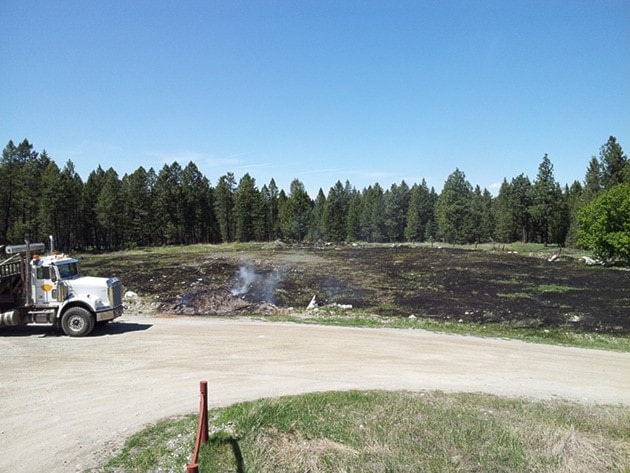A small fire at the fort Steele transfer station was quickly contained on Tuesday by a B.C. Wildfire crew and RDEK staff.
“We had a grass fire on our transfer station property yesterday afternoon when a controlled burn of a small brush pile got away,” says RDEK Solid Waste Superintendent Jim Penson. “Thanks to the swift action of a BC Wildfire Service crew, staff, contractors and a neighbour we were able to extinguish the fire very quickly and prevent the situation from becoming more serious.”
The blaze burned 1.5 hectares and was contained within three hours by two B.C. Wildfire Service personnel, RDEK staff, a neighbour and a water tender.
The incident is a stark reminder that wildfire season has arrived in the East Kootenay, indeed across the Southern Interior.
The City of Cranbrook is reminding residents that with proper community-wide preparation, populations and infrastructure can withstand the devastating effects of a wildfire, reducing loss of life and property. That preparation depends on strong collaboration between agencies and the public at the provincial and local levels.
"Many people move to the wild land urban interface, brining with them the same fire protection expectations they had when living in urban or other suburban communities," says Wayne Price, the Director of Fire and Emergency Services in Cranbrook. "The responsibility of the public is to understand and prepare for the risk of wild land fire. Homes that do not reflect the risk pose not only a threat to the residents themselves, but neighbouring homes and emergency services as well."
Important wild land fire preparedness concepts concepts include:
• Defensible space — The required space between a building structure and wildland area that surrounds it, creating a buffer between a home and radiant heat or flames.
• The Ember Issue — Windblown embers are a cause of concern in the wildland urban interface because most structures are not destroyed by direct flames, but rather from embers. Embers may precede the fire front, carried by winds that distribute burning brands or embers over long distances, which can ignite fuels on structures or property.
• Hardening your home — A conceptual plan that looks to protect a home through it's actual composition of roofs, eaves, vents, decks and windows.
• Home ignition zone — Another conceptual plan that places the home in the context of hits surroundings. In a high hazard area, this zone can extend up to 20 feet from a home and includes a preparation focus on the home and surrounding vegetation.
"There are various public education tools focusing on wild land fire preparedness from which individuals and homeowners can learn," Price said. "At the provincial level, these include the FireSmart Communities program. The program focuses on teaching residents how to adapt to living with wild land fire and encourages neighbours to jointly collaborate in a community-wide effort before a fire threat to prevent the loss of life and property."
For more information on the FireSmart Program, visit: http://bcwildfire.ca/prevention/firesmart.htm
The Southeast Fire Centre warns that fire danger rating in the Cranbrook area are moderate, with pockets of high.
"For the Cranbrook area, it looks like the danger rating is moderate with a couple pockets of high," said Karlie Shaughnessey, a Fire Information Officer with the SFC. "I know that we are supposed to get some light precipitation this evening and into tomorrow, so that will reduce the risk, but it looks like we're supposed to get some warmer temperatures coming for the weekend, so that will increase the risk."
Shaughnessey says that there have been 18 fires to date in the SFC that has burned 85 hectares — all save one being person-caused.
Activity is higher than normal, as the five year average for this time of year is nine fires that burns 44 hectares, she added.
